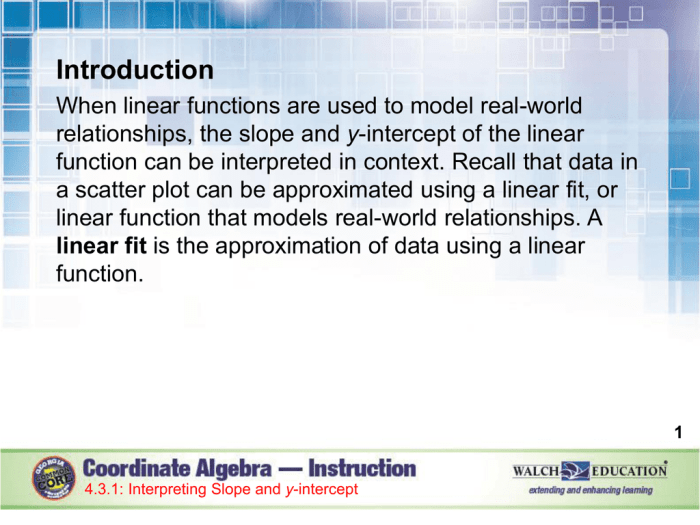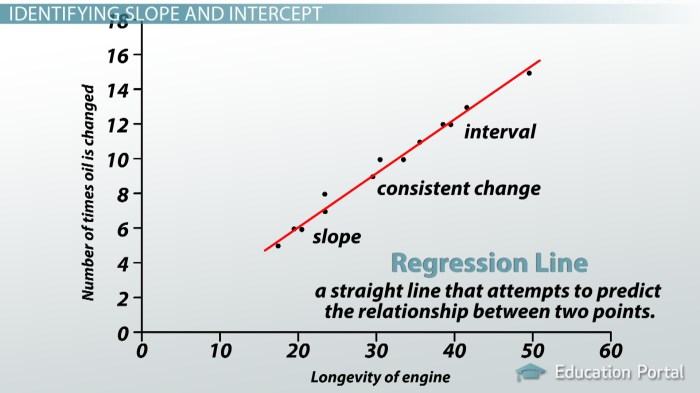Interpreting slope and y intercept worksheet – Embark on an educational journey with our in-depth Interpreting Slope and Y-Intercept Worksheet, meticulously crafted to unravel the intricacies of linear equations. Delve into the concept of slope as the rate of change, unravel the significance of the y-intercept as the line’s intersection with the y-axis, and witness the practical applications of these fundamental concepts in real-world scenarios.
This comprehensive guide analyzes the worksheet’s diverse questions and problems, equipping you with the strategies and techniques to tackle them effectively. Prepare to engage in thought-provoking practice exercises, where you’ll hone your skills in finding slope and y-intercept, unlocking a deeper understanding of linear equations.
Understanding Slope and Y-Intercept
In mathematics, a linear equation represents a straight line on a graph. Two key characteristics of a linear equation are its slope and y-intercept.
The slope of a line measures the rate of change in the y-coordinate for each unit change in the x-coordinate. It is calculated by dividing the change in y by the change in x. A positive slope indicates that the line rises from left to right, while a negative slope indicates that the line falls from left to right.
The y-intercept is the point where the line crosses the y-axis. It represents the value of y when x is equal to zero.
Understanding slope and y-intercept is crucial in analyzing linear relationships. They provide valuable insights into the behavior and characteristics of the line.
Real-World Examples
- The slope of a distance-time graph represents the speed of an object.
- The y-intercept of a temperature-time graph represents the initial temperature.
- The slope of a supply-demand curve represents the responsiveness of quantity supplied to changes in price.
Worksheet Analysis

The provided worksheet focuses on interpreting slope and y-intercept from various linear equations.
The worksheet includes:
- Questions that ask for the slope and y-intercept of given equations.
- Problems that require graphing a line given its slope and y-intercept.
- Applications of slope and y-intercept in real-world contexts.
To solve these problems effectively, students need to understand the concepts of slope and y-intercept, as well as the relationships between them.
Strategies and Techniques
- Use the slope formula: slope = (change in y) / (change in x)
- Identify the y-intercept by setting x = 0 in the equation.
- Plot points on the graph and draw a line to visualize the relationship.
Practice Exercises

| Step | Description |
|---|---|
| 1 | Write the equation of the line in slope-intercept form (y = mx + b) |
| 2 | Identify the slope (m) and y-intercept (b) from the equation |
| 3 | Plot the y-intercept on the y-axis |
| 4 | Use the slope to determine the rise and run from the y-intercept |
| 5 | Plot additional points and draw the line |
- Find the slope and y-intercept of the equation: y = 2x
5
- Graph the line with a slope of 1/2 and a y-intercept of 3.
- A car travels 200 miles in 4 hours. Find the slope and y-intercept of the distance-time graph.
Answer Keys:
- Slope: 2, y-intercept:
5
- [Image of the graph with slope 1/2 and y-intercept 3]
- Slope: 50 miles per hour, y-intercept: 0 miles
Extensions and Applications: Interpreting Slope And Y Intercept Worksheet
The concepts of slope and y-intercept can be extended to other areas of mathematics and have various real-world applications.
Calculus
In calculus, the derivative of a function represents the instantaneous rate of change, which is equivalent to the slope of the tangent line at any given point.
Statistics
In statistics, the slope of a regression line represents the correlation between two variables.
Real-World Applications, Interpreting slope and y intercept worksheet
- Physics: Calculating velocity and acceleration from distance-time graphs
- Economics: Analyzing supply and demand relationships
- Biology: Modeling population growth and decay
Additional Resources:
Key Questions Answered
What is the primary purpose of this worksheet?
To enhance your understanding of slope and y-intercept, equipping you with the skills to interpret and solve linear equations effectively.
What types of questions can I expect to encounter in this worksheet?
The worksheet encompasses a variety of questions, including identifying slope and y-intercept from equations, graphs, and real-world scenarios, as well as solving problems involving these concepts.
How can this worksheet benefit my mathematical abilities?
By completing this worksheet, you will strengthen your grasp of linear equations, improve your problem-solving skills, and develop a deeper understanding of slope and y-intercept.



